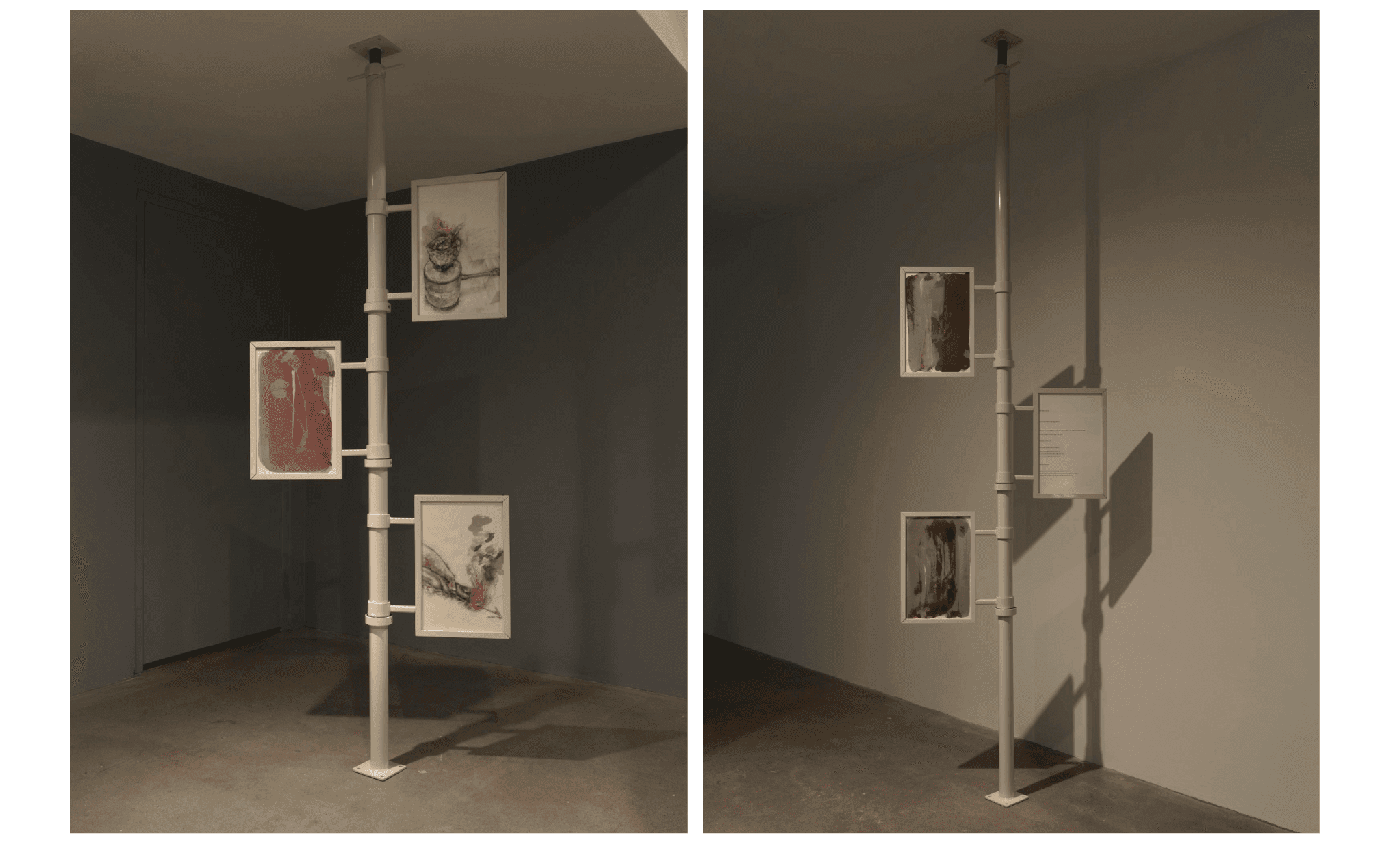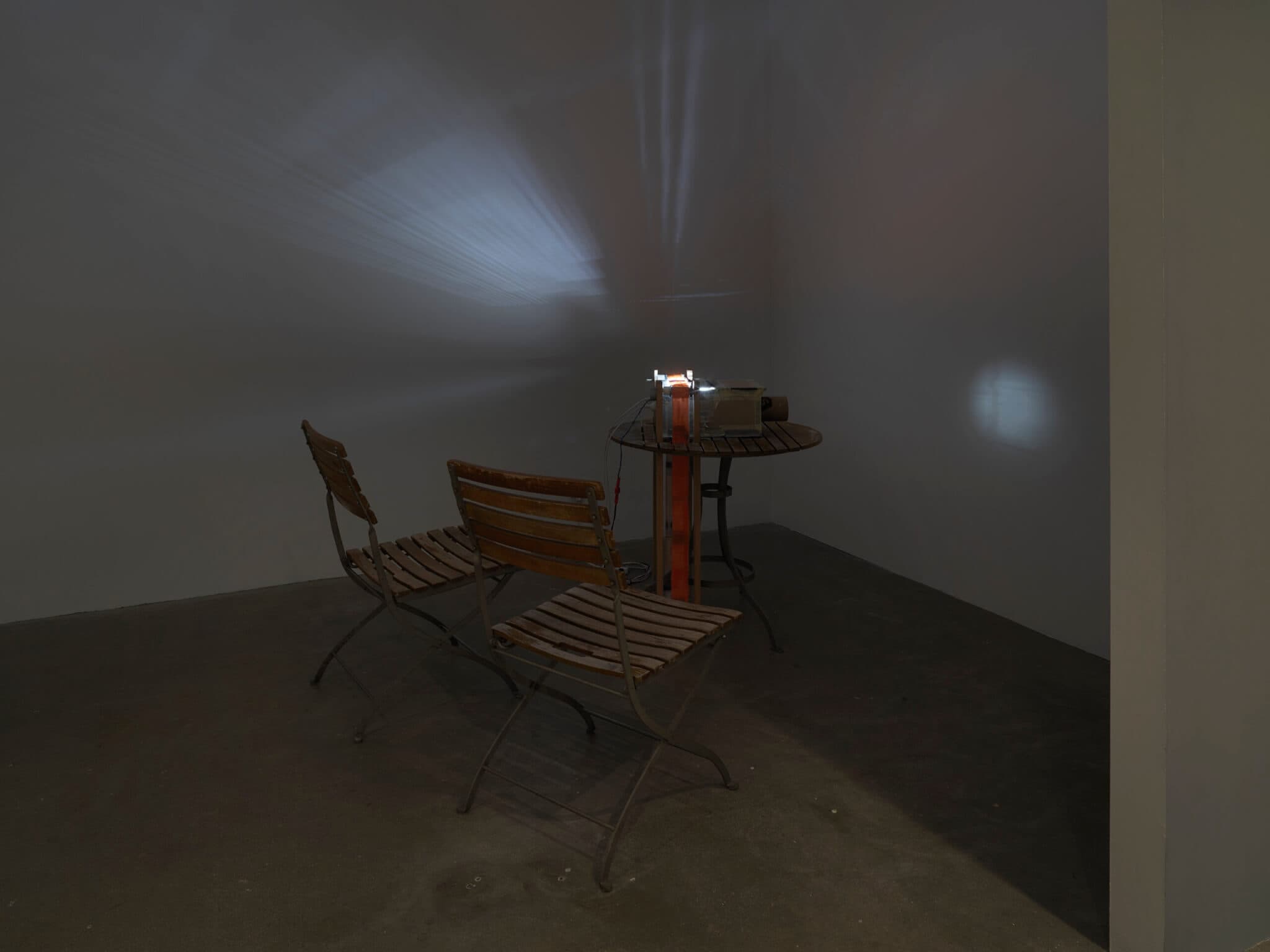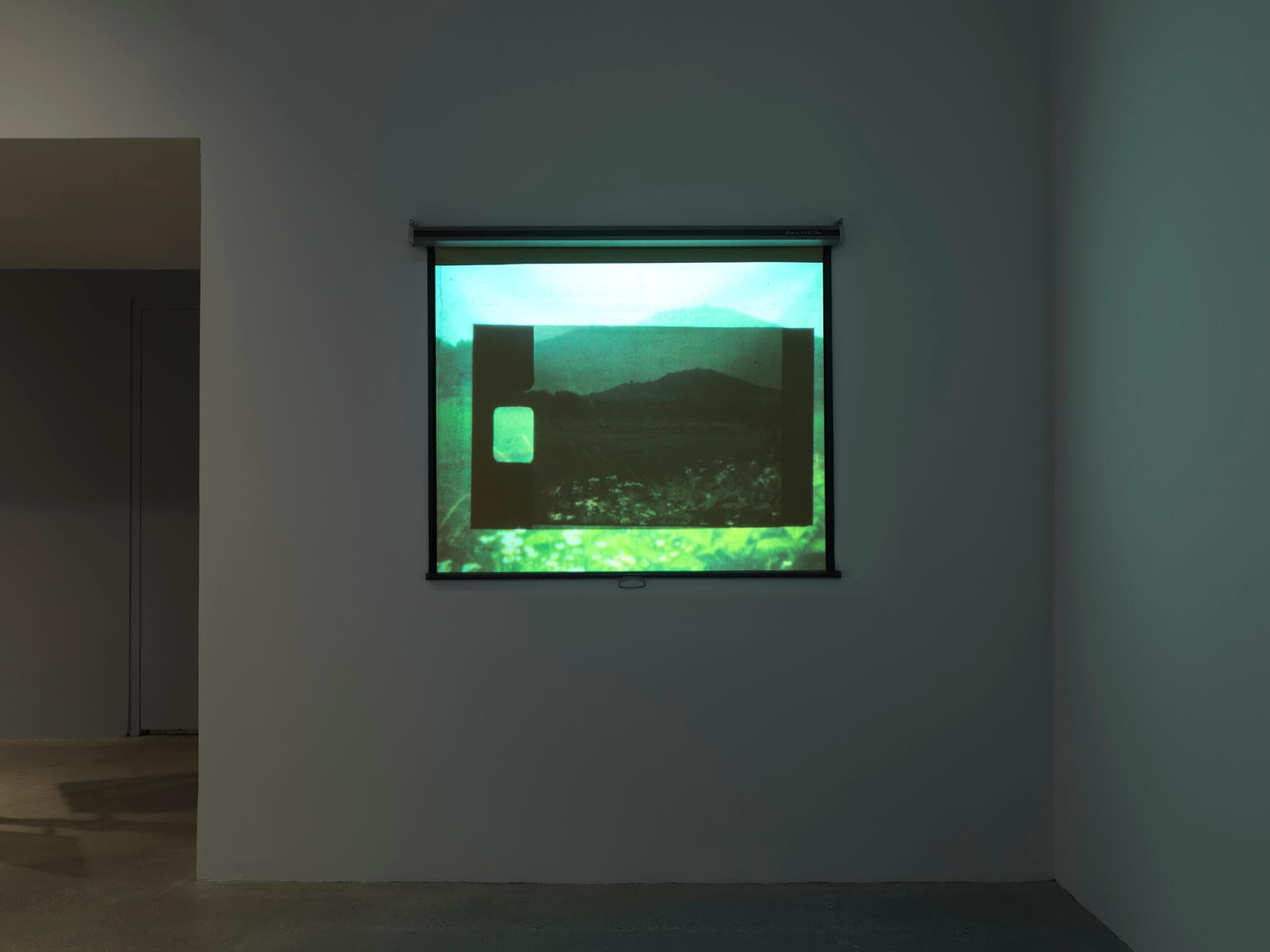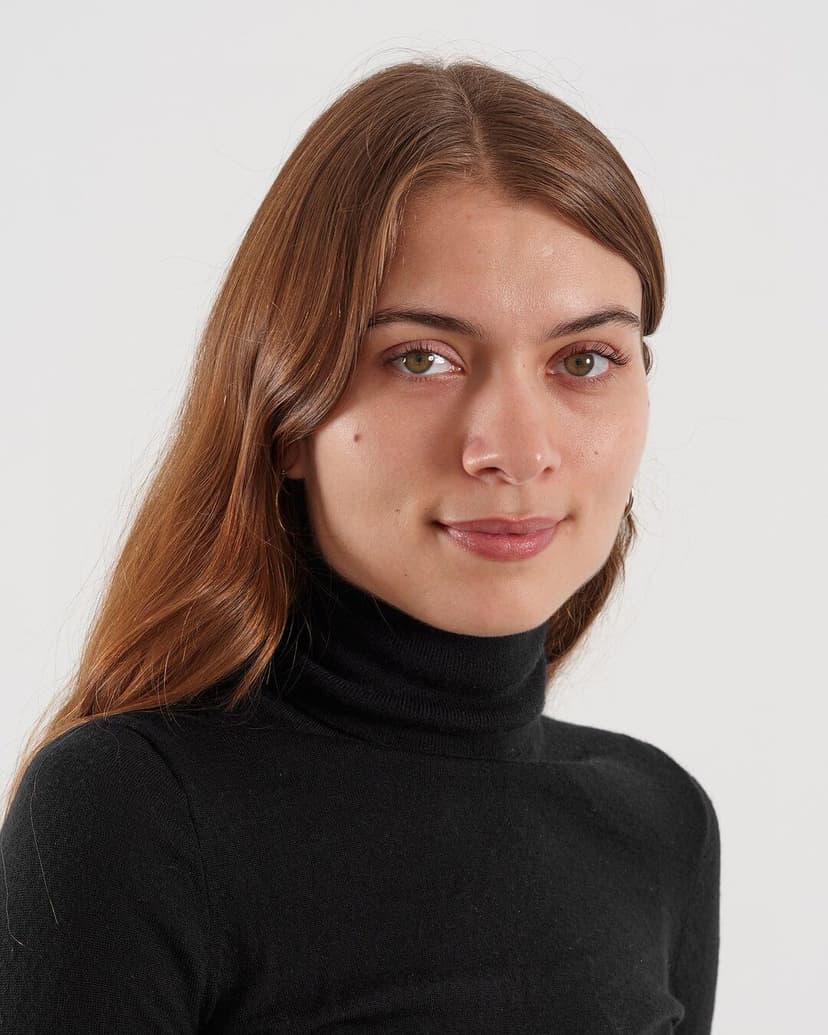Sophie Friedman-Pappas and TJ Shin’s exhibition, “List Projects 28” on view at MIT List Visual Arts Center through February 11, 2024 is a display of many parallels. Though Friedman-Pappas and Shin have been working and thinking in parallel for many years (including pursuing MFA degrees in tandem at UCLA), this is the first institutional presentation of their collaborative work.
“List Projects 28” presents two expanded cinema pieces as well as thirty-two mixed-media drawings that are installed flag-like across five floor-to-ceiling poles. The two sets of drawings—half belong to Shin and half to Friedman-Pappas—are framed back-to-back in a display structure that is evocative of didactic signage, and can be easily repositioned by viewers.
Invited by exhibition curator Selby Nimrod, the artists connected their disparate practices within a subversive and imaginary foray into the travelogue genre. The resulting artwork jointly questions and undermines the complex, collective histories that surround their sites of relation. Shin, who was born in South Korea, pulled subject matter from their trips to the Korean Demilitarized Zone (DMZ), a 150-mile-long border between South Korea and North Korea. Meanwhile, Friedman-Pappas references the tourism economy in Greece and New York City’s Financial District, two sites bearing her personal family history.

(left) Sophie Friedman-Pappas, Deltille-d Wall’s Necessary Anachronism 2, 2023. (middle) Sophie Friedman-Pappas and TJ Shin, Untitled (Travelogue 1-32), 2023. (right) TJ Shin, Duration (It takes 22,000 minutes or 367 hours to project 150 miles of film at 24 frames per second, which is the equivalent of walking an average pace of 0.41 miles per hour or 47 minutes per mile for 150 miles.), 2023. Installation view, “List Projects 28: Sophie Friedman-Pappas and TJ Shin,” MIT List Visual Arts Center, Cambridge, MA. On view through February 11, 2024.
Two expanded cinema pieces anchor the exhibition’s multilayered conceptual framework. Friedman-Pappas’ Deltille-d Wall’s Necessary Anachronism 2 (2023) encompasses two functional chairs, a table, and a scrappy, homemade projector that loops a silent, mixed-media “film” displaying printed words from an erotic, fictional narrative written by the artist. In the absurdist story, two unnamed lovers stay in a dovecote-turned-Airbnb on the Greek island of Tinos. Within this repurposed setting—a site that formerly housed pigeons and collected their droppings to be used as fertilizer—the lovers struggle to create an authentic experience of erotic intimacy, or of vacation. The lovers die when an unexpected fire heats the room to the temperature of a ceramic kiln. Only then do they climax—their bodies transformed into an ash glaze that adheres to the walls of the room.
The narrative is expanded upon in Friedman-Pappas’ drawings that function as a prologue to the projected text. Lover 1 keeps a journal as he travels from Los Angeles to New York, to Greece—the drawings on display represent his fictional travelogue. His accounts are also partially inspired by a recent experiment in which the artist dressed her sister as a surrogate to explore New York’s Financial District through “a tourist’s eyes.” The resulting drawings illustrate the character’s various engagements with the sites during the experiment—ranging from Noguchi’s Red Cube to the site of the 1920 Wall Street Bombing—and foretell the transformation of a stone building into a gas kiln.
Shin’s Duration (2023) comprises footage shot during the artist’s recent trips to the DMZ. They were granted unusual access to the heavily restricted area while working with the Research Ecology Institute (REI), a scientific organization that documents emergent and endangered species there. Using experimental, anachronistic methods, the artist physically manipulated the covertly shot analog film to create repetitions in its imagery that attempt to represent the intangibilities of nostalgia and déjà vu. The artist also gathered plant matter and State archives that they used to produce two different translations: phytograms, which translate physical plant matter into two-dimensional impressions, and excerpts of security records translated from Korean to English. The translations of these found materials make up Shin’s mixed-media pieces in the exhibition.
As both a curator and as a friend of the artists, I’ve observed their practices expand and change over time. My proximity to the work brings an informed and intimate perspective to the following interview, which has been edited for clarity.

Sophie Friedman-Pappas and TJ Shin, Untitled (Travelogue 1-32), 2023. Thirty-two mixed media works on paper, 17″×11″ each. Commissioned by MIT List Visual Arts Center. Courtesy the artists.
Moira Sims: In “List Projects 28,” you jointly present your works as tourists within your own sites of relation resulting in quasi-fictionalized travelogues—these sites range from the Korean DMZ to Tinos, Greece, to New York City’s Financial District. All three of these locales are highly trafficked tourist destinations. Can you describe your relationships to these locations?
TJ Shin: My project started in 2019 when I visited South Korea to attend a workshop organized by the DMZ Research Ecology Institute. Seventy years have passed since the Korean War and the signing of the 1953 Armistice Agreement, which forced a ceasefire into effect. The DMZ has since become an ecological haven for endangered species, while the rest of South Korea’s industrial, neoliberal development has accelerated. Militourism increasingly encroaches on the area, and ecological conservation serves to strengthen military securitization. Endangered species—the red-crowned crane, for example—now script nationalist aspirations for territorial legibility and citizenship as well as the promotion of state-sanctioned peace becoming a matter of biopolitical security. This made me question: in what ways do militarization and ecological conservation present historical amnesia?
In the summer of 2023, I worked with the REI again. Domestic civilians are only granted state-sanctioned access to DMZ tourist checkpoints, but the REI provided access into the “Forbidden Zone” and shared their research materials with me. I found it fascinating how political fantasies function in the borderscape and how propaganda spoke not only about the division of the Korean peninsula but about the symbiotic relationships between civilians, soldiers, and nonhuman life. My project examines: self-determination and political contingency beyond nation-state sovereignty, and the expulsion and movement of populations as the shared politics of the commons at the sake of one’s idealized homeland self-severed and estranged.
Sophie Friedman-Pappas: The conservation you’re describing, TJ, within the ecological site of the border reminds me of the manufactured stillness that’s so desired by tourists. There’s the stuckness of those who are already within that landscape and a promise of stillness given to the visitors. Tourism offers them a “Groundhog Day”: you and your family can come back to the exact same place year, after year, after year.

Sophie Friedman-Pappas, Deltille-d Wall’s Necessary Anachronism 2, 2023. Inverted camera obscura (homemade projector), mixed media, table, folding chairs; 10 min. Courtesy the artist.
MS: Both of you currently live in Los Angeles. I wonder how your physical and emotional distance from your sites of relation allow you to have a more critical perspective?
SFP: When I wanted to be home in New York but couldn’t, I began an exercise of practiced alienation. I would look downtown and try to see through other eyes. As I started to dissolve my singular self, everything seemed different: my family, my city. When I finally did go home, I wanted to maintain distance. My sister’s an actor and looks like me—it’s mostly our presentation of gender that’s different. So I thought she could be the right fit to play a part that’s part me. I put a wig and my clothes on her, and my sister in drag came to represent Lover 1, the character in my expanded cinema piece that goes onto Tinos, Greece, from his layover in New York.
When looking through the tourist’s, the voyeur’s, and Lover 1’s eyes, I saw the unoccupied floors of multiuse office buildings. My alter ego, Lover 1, represented by my sister in drag, started to imagine how the buildings could become “useful” again. He thought, “maybe a kiln?”
MS: I’m interested in your impulse to sever yourself from a place that is so familiar to you as well as a primary subject within your practice. You’ve produced so many mediations—to the point of creating a surrogate—to manufacture distance. We’ve also spoken about how you both are considering time within your work. There are multiple anachronistic moments throughout the exhibition, including Sophie’s usage of historical drawing techniques such as linear perspective and TJ’s analog film depictions of the DMZ, a place of historical amnesia. How does the negation of linear time, like a “Groundhog Day,” play into these mediations more broadly for you both, and how does approaching these sites with analog mediums amplify these disruptions?

TJ Shin, Duration (It takes 22,000 minutes or 367 hours to project 150 miles of film at 24 frames per second, which is the equivalent of walking an average pace of 0.41 miles per hour or 47 minutes per mile for 150 miles.), 2023. 16mm and Super 8 film transferred to digital; 7 min. Courtesy the artist.
TJS: My film explores the unproductive stability of ecology and security; the conservation of time and memory. In my expanded cinema piece I’m working with Super 8 and 16mm film footage shot during field research with REI and visits to DMZ observatories. I telescene, copy, splice, stitch, and tape the film, and repeat certain sequences and scenes. By splicing Super 8 film into single frames, movement becomes arrested into individual film stills overlaid on top of my 16mm footage. Time becomes continuous again when these isolated frames are played back and their differences become obscured. Separately, I have produced phytograms with plant life found at the DMZ—a cameraless technique using the internal chemistry of plants and sunlight. The resulting images are abstract compositions of successive shadows and light—representations of space and time. These techniques create impressionistic and structuralist time as a framework that surrounds the central motifs in my film: repetition and difference.
MS: Memory is inherently unstable and intangible. TJ, we’ve previously talked about dèjà vu as a motif in your work. Perhaps that’s a key link between memory and repetition—the involuntary aspect of déjà vu.
TJ: Yes, when you came and visited me at a residency this summer you made an important distinction between nostalgia and deja vu. Déjà vu is an involuntary image that fills your sight by force but carries out the object of its repetition through recognition. Nostalgia is a repressive memory that returns to knowledge you already know and subordinates the new, or the future, back into the past. These ideas of homeland and memory are so central in the psychic apparatus of nostalgia, where the past simply effectuates an analogy of likeness: motherland is the idea, diaspora becomes the image; the nation is the origin, and the citizen becomes the derivative. I am interested in the distinct temporal structures of déjà vu and nostalgia and using film to explore the social construction of images, their emergence, and mediations.

(left) Sophie Friedman-Pappas and TJ Shin, Untitled (Travelogue 1–32), 2023. (right) TJ Shin, Duration (It takes 22,000 minutes or 367 hours to project 150 miles of film at 24 frames per second, which is the equivalent of walking an average pace of 0.41 miles per hour or 47 minutes per mile for 150 miles), 2023. Installation view, “List Projects 28: Sophie Friedman-Pappas and TJ Shin,” MIT List Visual Arts Center, Cambridge, MA. On view through February 11, 2024.
SFP: TJ’s film splicing technique and their perversion of emplotment and ordering makes me think about nostalgia’s relationship to historical singularity. Any historical work is based on the ordering of events around a certain spectacle: the historian constructs a narrative by arranging events from a chronicle into a larger story. It has to have a discernible beginning, middle, and end: the holy trinity of narratology! It’s through that structure that ideology can be delivered.
If my projected text is an ordered historical narrative, the travelogue both a chronicle and prologue, and the epilogue an offsite object, the entire method of communicative history has gotten confused in an anachronistic mess. “Anachronism” is a word which appears in multiple titles of my work, in and out of this show.
“Necessary anachronism” is a term that György Lukács ascribed to the historical novel. Lukács felt that the writer must privilege their characters with an impossible historical knowledge, providing them with insight of both the past and future. I follow Lukács’s rule explicitly: Lover 1 predicts his own death. I don’t allow myself to arrive at the finality of a narrative or come to a conclusion—it’s like edging—which is funny, because the Lovers in my story only ejaculate in death. So, if you want an ending, it’s going to have to be the big one.
MS: I’d love to hear more about how the death drive and eroticism overlap in your work, Sophie.
SFP: My characters’ desire for the “real thing” is saturated with the colonial interests that are central to today’s travel industry and only climaxes in their own annihilation. These wants intersect when the Lovers bodies’ transmute into a glassy glaze on the walls of their Airbnb in their fiery deaths—a moment when they have also achieved permanent relocation to paradise.
TJS: Sophie, the way that you’re describing anachronism makes me question what happens to subjects that are not stabilized by historical time? Some fall into telos, a deterministic time. Your subjects are forever looped in Deltille-d Wall’s. What’s more deterministic than the circular nature of death drive, in which you sublate yourself to the position of the Other of your own Other? I would argue that your work is not about death, but rather the perpetual transference of value, and valorization of life.
MS: Expanding on that circularity, I also want to talk about mirroring. Mirroring, or the absence of a mirror, is a throughline in this exhibition—from TJ’s cameraless (and thus mirrorless) phytograms to the mirror incorporated in Sophie’s DIY projector. Also, within the gallery your respective drawings are hung back-to-back, inversely mirroring each other. How do you see mirrors operating within the conceptual frameworks you’re establishing?

Sophie Friedman-Pappas, Deltille-d Wall’s Necessary Anachronism 2, 2023. Inverted camera obscura (homemade projector), mixed media, table, folding chairs; 10 min. Courtesy the artist.
SFP: Regarding my literal use of mirrors, my mirrors don’t clarify things. I made the projector “bad.” The words in my film go in and out of focus and the mirror is faulty. A mirror promises truth in its reflection, but capital T “truth” is fascist! If I was going to have well-rendered drawings that mirror real subjects, then I had to insert an antagonism—in my drawings, the viewer’s potential hand is portrayed in a way to intervene.
TJS: Phytograms are a historical attempt at mirroring—they aim to produce an exact replica of nature. What’s different in the way that I’m presenting phytograms at MIT is that the salted prints are not chemically fixed, rendering them unstable. Over time they fade into muted purple, blurring materiality and its reality, and exploring the instability of representation.
The same goes for my prints of security and propaganda papers in English and Korean. Translation is a process of cultural knowledge production that transfers, or traces, from one language to another by selecting, constructing, and omitting grammars of value and power. Translation is therefore a language of difference, because the final result is never a faithful mirroring of the original.
SFP: This is also making me think about how exchange value can be said to place a mirror between commodities—the differences between two commodities disappears when each reflects the other’s value. In Deltille-d Wall’s […], the pigeon poop and ash glaze end up looking alike and stuck to the same places in the dovecote. Once the poop and ash have become “one,” the utility of both the lovers and their accommodations is gone.
It’s like Lover 1’s vision: in his hopes of usefulness and production—by making the buildings of the financial district into kilns—his profane utilitarianism ensures mechanical failure and the internal destruction of his apparatuses. In “List Projects 28,” my work envisions the halting of these “building kilns,” and of all vessels of production. I question putting any “waste” to work, or towards any productive means, unless it’s a means to thwart the system attempting to exploit it.
Sophie Friedman-Pappas (b. 1995, New York, NY) lives and works between Los Angeles and New York. Recent solo and two-person exhibitions include MIT List Visual Arts Center, Cambridge, MA; Meredith Rosen Gallery, New York, NY; in lieu, Los Angeles, CA; and Alyssa Davis Gallery (organized by Octagon), New York, NY. Selected group exhibitions include Soft Opening, London, UK; Bodenrader, Chicago, IL; Simone Subal Gallery, New York, NY; and Cuchifritos Gallery + Project Space, New York, among others.
TJ Shin (b. 1993, Seoul, South Korea) lives and works in Los Angeles. Shin has exhibited at the Queens Museum, Queens, NY; The Buffalo Institute of Contemporary Arts, Buffalo, NY; Lewis Center for the Arts at Princeton University, NJ; Roots & Culture Contemporary Art Center, Chicago, IL; The Bows, Mohkínstsis, Calgary, Alberta; Cuchifritos Gallery + Project Space, New York, NY; and Knockdown Center, Queens, New York, among others.
“List Projects 28: Sophie Friedman-Pappas and TJ Shin” is on view at MIT List Visual Arts Center through February 11, 2024.







